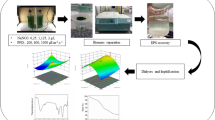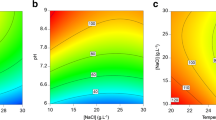Abstract
The effects of light intensity and temperature on Arthrospira platensis growth and production of extracellular polymeric substances (EPS) in batch culture were evaluated using a three-level, full-factorial design and response surface methodology. Three levels were tested for each parameter (temperature: 30, 35, 40°C; light intensity: 50, 115, 180 μmol photons m−2 s−1). Both growth and EPS production are influenced mainly by the temperature factor but the interaction term temperature*light intensity also had a significant effect. In addition, conditions optimising EPS production are different from those optimising growth. The highest growth rate (0.414 ± 0.003 day−1) was found at the lowest temperature (30°C) and highest light intensity (180 μmol photons m−2 s−1) tested, no optima were detectable within the given test range. Obviously, optima for growth must be at a temperature lower than 30°C and a light intensity higher than 180 μmol photons m−2 s−1. For EPS production, light intensity had a positive linear effect (optimum obviously higher than 180 μmol photons m−2 s−1), but for the temperature parameter a maximum effect was detectable at 35°C.




Similar content being viewed by others
References
Cohen Z, Reungjitchachawali M, Angdung W, Tanticharoen M (1993) Production and partial purification of γ-linolenic acid and some pigments from Spirulina platensis. J Appl Phycol 5:109–115
Cornet JF, Dussap CG, Dubertret GA (1992) Structured model for simulation of cultures of the cyanobacterium Spirulina platensis in photobioreactors: I. Coupling between light transfer and growth kinetics. Biotechnol Bioeng 40:817–825
Costa JAV, Colla LM, Duarte Filho PF, Kabke K, Weber A (2002) Modelling of Spirulina platensis growth in fresh water using response surface methodology. World J Microbiol Biotechnol 18:603–607
De Philippis R, Vincenzini M (1998) Exocellular polysaccharide from cyanobacteria and their possible applications. FEMS Microbiol Rev 22:151–175
Deshnium P, Paithoonrangsarid K, Suphatrakul A, Meesapyodsuk D, Tanticharoen M, Cheevadhanarak S (2000) Temperature-independent and dependent expression of desaturase genes in filamentous cyanobacterium Spirulina platensis strain C1 (Arthospira sp.PCC 9438). FEMS Microbiol Lett 184:207–213
Dueñas M, Munduate A, Perea A, Irastorzaet A (2003) Exopolysaccharide production by Pediococcus damnosus 2.6 in a semidifined medium under different growth conditions. Int J Food Microbiol 87:113–120
Estrada JE, Besco’s P, Villar Del Fresno AM (2001) Antioxidant activity of different fractions of Spirulina platensis protean extract. Il Farmaco 56:497–500
Filali Mouhim R, Cornet JF, Fontaine T, Fournet B, Dubertret G (1993) Production, isolation and preliminary characterisation of the exopolysaccharide of the cyanobacterium Spirulina platensis. Biotechnol Lett 15:567–572
Herms DA, Mattson WJ (1992) The dilemma of plants grow or defend. Q Rev Biol 67:283–335
Kim D, Pendersen H, Chin CK (1988) Effects of light on berberine production in cell suspension cultures of Thalictrum rugosu. Biotech Lett 10:709–712
Kumar SS, Chaubey RC, Devasagayam TPA, Priyadarsini KI, Chauhan PS (1999) Inhibition of radiation-induced DNA damage in plasmid pBR322 by chlorophyllin and possible mechanism of action. Mutation Res 425:71–79
Nicolaus B, Panico A, Lama L, Romano I, Manca MC, De Giulio A, Gambacorta A (1999) Composition and production of exopolysaccharides from representative members of heterocystous and non-heterocystous cyanobacteria. Phytochem 52:639–647
Otero A, Vincenzini M (2003) Extracellular polysaccharide synthesis by Nostoc strains as affected by N source and light intensity. J Biotechnol 102:143–152
Parikh A, Madamwar D (2006) Partial characterization of extracellular polysaccharides from cyanobacteria. Bioresour Technol 97:1822–1827
Shohael AM, Ali MB, Yu KW, Hahn EJ, Islam R, Paek KY, Alonso D, Maroto F (2000) Plant as chemical factories’ for the production of polyunsaturated fatty acids. Biotechnol Adv 18:481–497
Taiz L, Zeiger E (1998) Photosynthesis: physiological and ecological considerations. In: Taiz L, Zeiger E (eds) Plant physiology. Sinauer, Sunderland, MA, pp 227–249
Tseng CT, Zhao Y (1994) Extraction, purification and identification of polysaccharides of Spirulina (Arthrospira) platensis (Cyanophyceae). Alg Stud 75:303–312
Vonshak A (1997) Spirulina: growth, physiology and biochemistry. In: Vonshak A (ed) Spirulina platensis (Arthrospira): Physiology, Cell-biology and biotechnology. Taylor and Francis, London, pp 43–66
Wingender J, Neu RT, Flemming H-C (1999) What are bacterial extracellular polymeric substances? In: Wingender J, Neu RT, Flemming H-C (eds) Microbiol extracellular polymeric substances characterization, structure and function. Springer, Berlin, pp 1–13
Wolfstein K, Stal LJ (2002) Production of extracellular polymeric substances (EPS) by benthic diatoms: effect of irradiance and temperature. Mar Ecol Prog Ser 236:13–22
Yim HJ, Kim SJ, Ahn SH, Lee HK (2003) Optimal conditions for the production of sulphated polysaccharide by marine microalga Gyrodinium impudicum strain KG 03. Biomolec Eng 20:273–280
Zarrouk C (1966) Contribution à l’étude d’une cyanophycée. Influence de divers facteurs physiques et chimiques sur la croissance et la photosynthèse de Spirulina maxima Geitler. PhD Thesis, University of Paris
Author information
Authors and Affiliations
Corresponding author
Rights and permissions
About this article
Cite this article
Trabelsi, L., Ben Ouada, H., Bacha, H. et al. Combined effect of temperature and light intensity on growth and extracellular polymeric substance production by the cyanobacterium Arthrospira platensis . J Appl Phycol 21, 405–412 (2009). https://doi.org/10.1007/s10811-008-9383-8
Received:
Revised:
Accepted:
Published:
Issue Date:
DOI: https://doi.org/10.1007/s10811-008-9383-8




